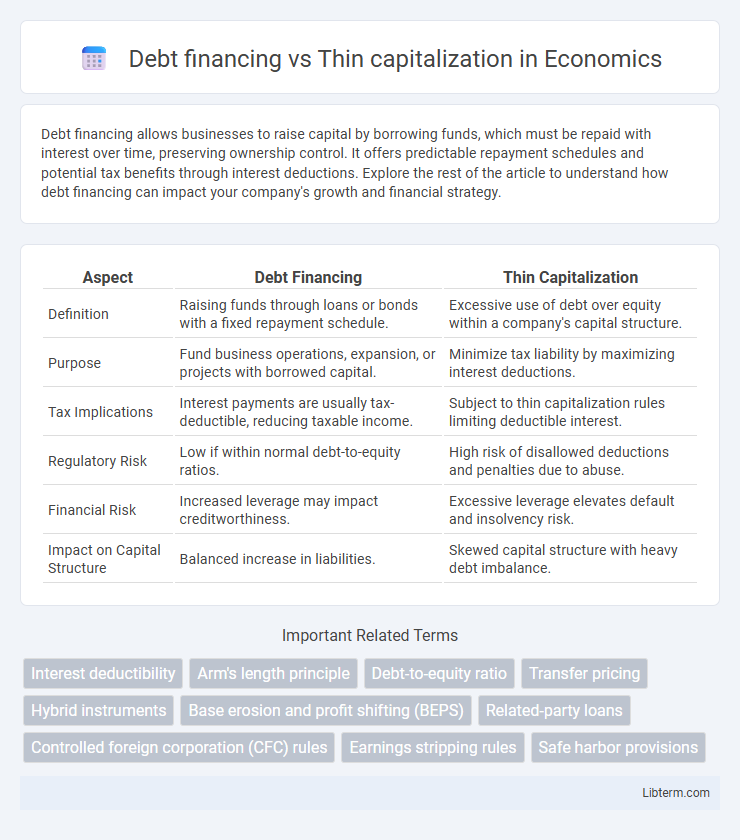Debt financing allows businesses to raise capital by borrowing funds, which must be repaid with interest over time, preserving ownership control. It offers predictable repayment schedules and potential tax benefits through interest deductions. Explore the rest of the article to understand how debt financing can impact your company's growth and financial strategy.
Table of Comparison
| Aspect | Debt Financing | Thin Capitalization |
|---|---|---|
| Definition | Raising funds through loans or bonds with a fixed repayment schedule. | Excessive use of debt over equity within a company's capital structure. |
| Purpose | Fund business operations, expansion, or projects with borrowed capital. | Minimize tax liability by maximizing interest deductions. |
| Tax Implications | Interest payments are usually tax-deductible, reducing taxable income. | Subject to thin capitalization rules limiting deductible interest. |
| Regulatory Risk | Low if within normal debt-to-equity ratios. | High risk of disallowed deductions and penalties due to abuse. |
| Financial Risk | Increased leverage may impact creditworthiness. | Excessive leverage elevates default and insolvency risk. |
| Impact on Capital Structure | Balanced increase in liabilities. | Skewed capital structure with heavy debt imbalance. |
Introduction to Debt Financing
Debt financing involves raising capital through borrowing, typically by issuing bonds or obtaining loans, which must be repaid with interest over time. This method enables companies to leverage external funds without diluting ownership, enhancing cash flow for growth or operations. Understanding the balance between debt financing and thin capitalization, which occurs when excessive debt compared to equity leads to tax or regulatory issues, is crucial for optimizing capital structure and minimizing financial risks.
Understanding Thin Capitalization
Thin capitalization occurs when a company is financed through a high level of debt compared to equity, often raising concerns about excessive interest deductions and tax base erosion. Debt financing enables businesses to access capital through loans or bonds but can trigger thin capitalization rules designed to limit interest expense deductions when leverage exceeds regulatory thresholds. Understanding thin capitalization is essential for optimizing tax efficiency and compliance with transfer pricing and anti-avoidance regulations.
Key Differences Between Debt Financing and Thin Capitalization
Debt financing involves raising capital through borrowing, typically from banks or bond issuance, with an obligation to repay principal and interest. Thin capitalization specifically refers to a company's capital structure with an excessively high level of debt relative to equity, often triggering tax regulations that restrict interest deductions. Key differences include the broader scope of debt financing as a funding method, while thin capitalization focuses on regulatory implications and tax limits due to imbalanced debt-to-equity ratios.
Advantages of Debt Financing
Debt financing offers companies tax-deductible interest payments, which can lower overall tax liability and improve cash flow management. It provides flexibility in capital structure without diluting ownership or control, making it attractive for maintaining shareholder equity. Access to debt financing can also enhance creditworthiness and support growth initiatives through predictable repayment schedules.
Risks and Limitations of Debt Financing
Debt financing carries significant risks such as increased financial leverage, which may lead to higher interest obligations and potential cash flow constraints. Thin capitalization rules impose limitations by restricting excessive debt-to-equity ratios, increasing the risk of disallowed interest deductions and tax penalties. These regulations aim to prevent abuse of debt funding, ensuring companies maintain balanced capital structures to avoid solvency issues and fiscal non-compliance.
Impact of Thin Capitalization on Taxation
Thin capitalization occurs when a company is financed through a high level of debt compared to equity, often leading to excessive interest deductions that reduce taxable income. Tax authorities impose thin capitalization rules to limit interest expense deductions and prevent base erosion through profit shifting. These regulations affect multinational corporations by restricting the tax benefits of debt financing, thus increasing their effective tax liability.
Regulatory Framework for Thin Capitalization
Thin capitalization regulations restrict the amount of debt that a company can use to finance its operations to prevent excessive debt funding and profit shifting. These rules typically impose debt-to-equity ratio limits, ensuring that interest deductions on excessive debt are disallowed for tax purposes, thereby curbing tax base erosion. Jurisdictions such as the OECD recommend specific guidelines under the Base Erosion and Profit Shifting (BEPS) action plans to harmonize thin capitalization rules globally, promoting fair tax compliance and reducing abuse of debt financing.
Strategies to Avoid Thin Capitalization Issues
Tax authorities scrutinize debt financing strategies to prevent excessive interest deductions linked to thin capitalization rules, which limit the allowable debt-to-equity ratio. To avoid thin capitalization issues, companies should maintain a balanced capital structure by increasing equity contributions or reducing debt levels, ensuring compliance with local debt-to-equity thresholds. Implementing transfer pricing adjustments and documenting arm's length interest rates further mitigates risks of recharacterization or denial of interest deductions under thin capitalization rules.
Global Perspectives on Debt Financing and Thin Capitalization
Global perspectives on debt financing reveal varying regulatory frameworks aimed at balancing corporate leverage and tax compliance, with thin capitalization rules implemented to limit excessive debt-to-equity ratios that erode tax bases. Countries such as the United States, Germany, and Australia enforce stringent thin capitalization standards to prevent profit shifting and base erosion, directly influencing multinational corporations' capital structures. Comparative analysis highlights that jurisdictions with aggressive thin capitalization rules often see increased equity financing, impacting global investment strategies and cross-border financial planning.
Best Practices for Optimal Capital Structure
Debt financing enables companies to leverage tax shields and maintain control without diluting equity, whereas thin capitalization concerns arise when excessive debt increases financial risk and triggers tax challenges. Best practices for optimal capital structure involve balancing debt-to-equity ratios to ensure sufficient leverage for growth while avoiding regulatory scrutiny and financial distress. Maintaining compliance with thin capitalization rules requires regular monitoring of interest coverage ratios and adjusting financing strategies to optimize tax efficiency and creditworthiness.
Debt financing Infographic

 libterm.com
libterm.com